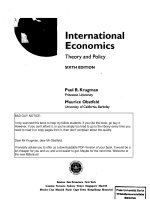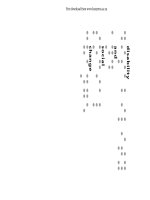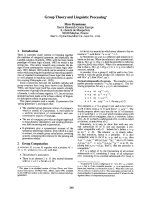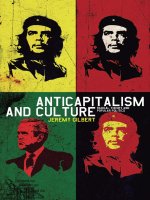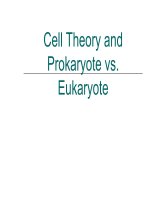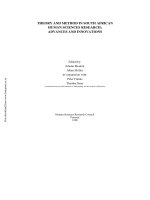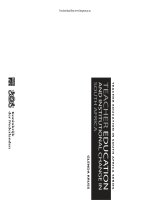Paramater theory and linguistic change
Bạn đang xem bản rút gọn của tài liệu. Xem và tải ngay bản đầy đủ của tài liệu tại đây (1.98 MB, 405 trang )
Tai Lieu Chat Luong
Parameter Theory and Linguistic Change
OXFORD STUDIES IN DIACHRONIC AND
HISTORICAL LINGUISTICS
GENERAL EDITORS
Adam Ledgeway and Ian Roberts, University of Cambridge
ADVISORY EDITORS
Cynthia Allen, Australian National University; Ricardo Bermúdez-Otero, University of Manchester; Theresa Biberauer, University of Cambridge; Charlotte Galves, University of Campinas;
Geoff Horrocks, University of Cambridge; Paul Kiparsky, Stanford University; Anthony Kroch,
University of Pennsylvania; David Lightfoot, Georgetown University; Giuseppe Longobardi,
University of Trieste; David Willis, University of Cambridge
PUBLISHED
1
From Latin to Romance
Morphosyntactic Typology and Change
Adam Ledgeway
2
Parameter Theory and Linguistic Change
Edited by Charlotte Galves, Sonia Cyrino, Ruth Lopes, Filomena Sandalo, and
Juanito Avelar
3
Case in Semitic
Roles, Relations, and Reconstruction
Rebecca Hasselbach
4
The Boundaries of Pure Morphology
Diachronic and Synchronic Perspectives
Edited by Silvio Cruschina, Martin Maiden, and John Charles Smith
in preparation
The History of Negation in the Languages of Europe and the Mediterranean
Vol. I: Case Studies; Vol. II: Patterns and Processes
Edited by Anne Breitbarth, Chris Lucas, and David Willis
Gender from Latin to Romance
Michele Loporcaro
Vowel Quantity from Latin to Romance
Michele Loporcaro
Word Order in Old Italian
Cecilia Poletto
Syntactic Change and Stability
Joel Wallenberg
Parameter Theory and
Linguistic Change
Edited by
CHARLOTTE GALVES, SONIA CYRINO,
RUTH LOPES, FILOMENA SANDALO, AND
JUANITO AVELAR
1
3
Great Clarendon Street, Oxford, ox2 6dp,
United Kingdom
Oxford University Press is a department of the University of Oxford.
It furthers the University’s objective of excellence in research, scholarship,
and education by publishing worldwide. Oxford is a registered trade mark of
Oxford University Press in the UK and in certain other countries
© editorial matter & organization editors; chapters their several authors 2012
The moral rights of the authors have been asserted
First Edition published in 2012
Impression: 1
All rights reserved. No part of this publication may be reproduced, stored in
a retrieval system, or transmitted, in any form or by any means, without the
prior permission in writing of Oxford University Press, or as expressly permitted
by law, by licence or under terms agreed with the appropriate reprographics
rights organization. Enquiries concerning reproduction outside the scope of the
above should be sent to the Rights Department, Oxford University Press, at the
address above
You must not circulate this work in any other form
and you must impose this same condition on any acquirer
British Library Cataloguing in Publication Data
Data available
Library of Congress Cataloging in Publication Data
Data available
ISBN 978–0–19–965920–3
Printed in Great Britain
on acid-free paper by
MPG Books Group, Bodmin and King’s Lynn
Contents
List of figures and tables
Notes on contributors
Abbreviations
1 Parameter theory and dynamics of change
Charlotte Galves, Sonia Cyrino, and Ruth Lopes
vii
ix
xiii
1
2 Parameters in Old Romance word order: A comparative minimalist
analysis
Guido Mensching
21
3 Microparameters in the verbal complex: Middle High German and
some modern varieties
Christopher D. Sapp
43
4 Language acquisition in German and phrase structure change
in Yiddish
Joel C. Wallenberg
60
5 Extraposition of restrictive relative clauses in the history of Portuguese
Adriana Cardoso
77
6 Doubling-que embedded constructions in Old Portuguese:
A diachronic perspective
Ilza Ribeiro and Maria A. Torres Morais
97
7 Brazilian Portuguese and Caribbean Spanish: Similar changes
in Romania Nova
Mary Aizawa Kato
117
8 Macroparametric change and the synthetic–analytic dimension:
The case of Ancient Egyptian
Chris H. Reintges
133
9 A diachronic shift in the expression of person
Judy B. Bernstein and Raffaella Zanuttini
158
10 The formal syntax of alignment change
John Whitman and Yuko Yanagida
177
11 The diachronic development of the Irish comparative particle
Elliott Lash
196
vi
Contents
12 Deictic locatives, emphasis, and metalinguistic negation
Ana Maria Martins
13 Negative changes: three factors and the diachrony of
Afrikaans negation
Theresa Biberauer and Hedde Zeijlstra
14 Romanian ‘can’: Change in parametric settings
Virginia Hill
214
238
265
15 Prepositional genitives in Romance and the issue of parallel
development: From Latin to Old French
Chiara Gianollo
281
16 Convergence in parametric phylogenies: Homoplasy or
principled explanation?
Giuseppe Longobardi
304
17 Macroparameters and minimalism: A programme for
comparative research
Ian Roberts
320
References
Name index
Subject index
336
371
377
List of figures and tables
Figure 3.1 Rate of 2-1 and 1-2 orders over time
52
Figure 4.1 Tense-final and tense-medial chart 1
Figure 4.2 Tense-final and tense-medial chart 2
70
74
Figure 4.3 Tense-final and tense-medial chart 3
75
Figure 7.1 Loss of VS and increase of pre-verbal pronominal subjects
Figure 7.2 Percentage of non-inversion by subject type
121
123
Figure 15.1 The disappearance of the inflected genitive
Figure 16.1 Phylogenetic tree from Longobardi and Guardiano (2009)
292
307
Table 3.1 Syntagm
46
Table 3.2 Prefix type
47
Table 3.3 Class of preceding word
Table 3.4 Stress of preceding word
47
48
Table 3.5 Focus type
Table 3.6 Focused constituent
48
49
Table 3.7 Extraposition
50
Table 3.8 Genre
Table 3.9 Verbal-complex orders in modern varieties
51
53
Table 3.10 Parameters for the position of verbs in continental
West Germanic
58
Table 4.1 Tense-final and tense-medial sample corpora
Table 7.1 Full DP subjects in VS and SV structures
69
123
Table 8.1 Main parametric differences between the agglutinative
and analytic system
156
Table 9.1 Rate of –s marking for 3rd-person plural subject
types (N¼527)
163
Table 9.2 Rate of –s marking with non-adjacent personal pronoun
subjects (N¼170)
164
Table 10.1 The active system in nominalized clauses
189
Table 15.1 Distribution of genitives in Late Latin
Table 15.2 Distribution of adjectives in Late Latin
287
288
Table 15.3 Co-occurrence of genitives in Classical Latin
288
viii
List of figures and tables
Table 15.4 Old and Middle French texts from the MCVF corpus
used in the study
Table 15.5 Prepositional versus inflected genitives in the Vie de
Saint Alexis
Table 15.6 Case declension in Old French
290
291
292
Table 15.7 Distribution of inflected genitives in Old French
Table 15.8 Co-occurence of adjectives and genitives
293
298
Table 16.1 Parameter values (adapted from Longobardi and
Guardiano 2009)
316
Table 16.2 Distance matrix (from Longobardi and Guardiano 2009)
318
Notes on contributors
Juanito Avelar studied in Rio de Janeiro and Campinas and is currently Associate
Professor at the University of Campinas. He has published on syntactic variation
and on the history of Brazilian Portuguese. His publications include Ter, ser e estar:
dinâmicas morfossintáticas no português brasileiro (RG Editora, 2009) and, co-edited
with Fernão de Oliveira, Um gramático na história (Pontes, 2009).
Judy B. Bernstein is Associate Professor of Linguistics at the William Paterson
University of New Jersey. Her interest in cross-linguistic phenomena at the morphology-syntax interface led to extensive research on the syntax of the noun phrase. In
recent years she has also become involved in research on Appalachian English, a
stigmatized variety of American English. This work sparked interest in the ancestor
variety of Appalachian English, Older Scots, as well as the ancestor varieties of
standard English.
Theresa Biberauer is a Senior Research Associate in the Department of Theoretical
and Applied Linguistics at the University of Cambridge, and Senior Lecturer Extraordinary in the General Linguistics Department at Stellenbosch University (South
Africa). Her research focuses on comparative syntax, notably word-order variation,
subject-related phenomena, negation, and doubling phenomena. She is the editor of
The Limits of Syntactic Variation (Benjamins, 2008) and, with Anders Holmberg, Ian
Roberts, and Michelle Sheehan, a co-author of Parametric Variation (CUP, 2010).
Adriana Cardoso is a researcher at the Linguistics Center of the University of
Lisbon (CLUL) and lectures at Higher Education College of Lisbon (ESELx). Her
PhD dissertation is in Historical Linguistics (Variation and Change in the Syntax of
Relative Clauses: New Evidence from Portuguese). Her main research interests are
comparative syntax, historical linguistics, and native language teaching.
Sonia Cyrino studied at the University of Campinas where she is currently
Associate Professor. She has been a Visiting Scholar at the University of Maryland
at College Park and at the University of Cambridge (UK). She is interested in
syntactic theory and diachronic change in Brazilian Portuguese. Her publications
include chapters in the iGoing Romancer series (John Benjamins) and articles in
international journals such as Journal of Portuguese Linguistics and Iberia-International Journal on Theoretical Linguistics
Charlotte Galves studied in Paris (Paris IV- Sorbonne and Paris VIII-Vincennes)
and is currently Associate Professor of Linguistics at the University of Campinas.
She has published on the comparative syntax of European and Brazilian Portuguese
x
Notes on contributors
from both synchronic and diachronic perspectives. She coordinates the elaboration
of the Tycho Brahe Parsed Corpus of Historical Portuguese. Her publications
include Ensaios sobre as gramáticas do português and, as co-editor, África-Brasil:
Caminhos da Lingua Portuguesa (Editora da Unicamp, 2001 and 2009).
Chiara Gianollo is a researcher and lecturer (Akademische Rätin auf Zeit) in
Linguistics at the University of Cologne, and an associated fellow of the Zukunftskolleg,
University of Konstanz. She received her doctoral degree in Linguistics from the University of Pisa in 2005. Her research interests are centred on modeling linguistic variation
and the dynamics of language change. She is currently developing a research project on
the comparative syntax of adnominal arguments in ancient Indo-European languages.
Virginia Hill is Professor of Linguistics at the University of New Brunswick –
Saint John. She specializes in the diachronic syntax of Early Modern Romanian and
on the pragmatics-syntax interface.
Mary Aizawa Kato is a Full Professor at the University of Campinas (UNICAMP),
Brazil, where she still works as a voluntary collaborator after having retired. Her
main areas of research and teaching are: comparative syntax, historical linguistics,
and language acquisition. She is presently coordinating, with Francisco Ordoñez
(SUNY, Stonybrook), the project Romania Nova, sponsored by CNPq (grant 301219/
2008-7), which is concerned with comparative studies of the Romance languages
spoken in the Americas.
Elliott Lash has recently completed a PhD at the University of Cambridge and
he is currently a researcher at the Dublin Institute for Advanced Studies, where he is
building a POS tagged and parsed corpus of Irish texts. He is interested in the history
of Irish syntax, especially copula clauses, verbal nouns, secondary predication, and
word order. More broadly, he is interested in syntactic reconstruction (especially of
Indo-European languages), the use of features/feature structures in Minimalism, and
linearization algorithms.
Giuseppe Longobardi is Professor of Linguistics at the University of Trieste, and
on the Neurosciences program staff at SISSA, Trieste. He was a visiting professor at
Vienna, USC, Harvard, UCLA, and was Directeur de Recherche Etranger at the
CNRS in Paris (2003). He has written on theoretical and historical syntax in
international journals (Linguistic Inquiry, Lingua, Zeitschrift f. Sprachwissenschaft,
Natural Language Semantics, Linguistic Variation Yearbook), and authored, edited,
or contributed to volumes published by major scientific publishers.
Ruth Lopes joined the University of Campinas in 2006 where she is an Associate
Professor. She has been a visiting researcher at the University of Maryland at College
Park and at the University of Massachusetts at Amherst. Her interests are language
acquisition and the syntax-semantics interface. She is the co-authorm, with Carlost
Mioto and Maria Cristina Figueiredo Silva of Novo Manual de Sintaxe (Insular, 2004).
Notes on contributors
xi
Ana Maria Martins is Associate Professor at the Universidade de Lisboa. She has
published on different topics of Portuguese and Romance syntax, in a comparative
perspective: word order, clitics, negative polarity items, emphatic affirmation, impersonal
se, (inflected) infinitives, (hyper-)raising, negation. Several of her papers are published in
the Linguistic series of Oxford University Press and John Benjamins. She coordinates the
project Syntax-oriented Corpus of Portuguese Dialects (CORDIAL-SIN).
Guido Mensching is Professor of Romance Linguistics at the Freie Universität
Berlin. He has published extensively on Romance lexicology of the Middle Ages,
including La sinonima delos nonbres delas medeỗinas (Madrid: Arco Libros 1994), on
Sardinian, and on the syntax of the Romance languages. For the latter, he works
within the generative framework (see his Infinitive Constructions with Specified
Subjects: A Syntactic Analysis of the Romance Languages, OUP, 2000).
Chris H. Reintges is a senior researcher (Chargé de recherche, 1ère classe) at the
Centre National de la Recherche Scientifique (CNRS) at University Paris 7. He received
his PhD in linguistics at the University of Leiden, Netherlands, in 1997, with a
dissertation on Passive Voice in Older Egyptian: Morphosyntactic Study. Subsequently
he worked extensively on focus-sensitive constructions in Coptic Egyptian, including
wh-in-situ questions, relative clauses, cleft sentences, and coordinative structures. He
published an extensive reference grammar on Coptic Egyptian (Sahidic Dialect): A
Learner’s Grammar (Cologne: Rüdiger Köppe Verlag). His research interests include
parameter theory, historical linguistics and language change, and comparative syntax
(with particular emphasis on Afroasiatic languages and Brazilian Portuguese).
Ilza Ribeiro is Professor of Linguistics at the University of Bahia. She has written
widely on aspects of diachronic syntax, language change, and variation. She has also
widely published on particular phenomena of Old Portuguese. She is currently
working on a Brazilian Portuguese historical project and on written and spoken
African Portuguese in Brazil.
Ian Roberts is Professor of Linguistics at the University of Cambridge and Professorial Fellow at Downing College. He has previously held Chairs at the University of
Wales, Bangor University, and Stuttgart University. He is the author of five monographs and two textbooks, and has written many articles on diachronic syntax, as
well as the syntax of the Germanic, Romance, and Celtic languages.
Filomena Sandalo has a PhD from the University of Pittsburg and is currently
Associate Professor at the University of Campinas. She was a Post-Doctoral Associate 1996 to 1998 and a visiting scholar in 2001 and 2010–2011 at MIT. She has
published on phonology and morphology of Portuguese and the native languages of
South America. Her publications include A Grammer of Kadiwéu (MIT Occasional
Papers in Linguistics 11, 1997).
xii
Notes on contributors
Christopher D. Sapp is Assistant Professor of German and Linguistics at the
University of Mississippi. Dr. Sapp holds a PhD in Germanic Linguistics from
Indiana University (2006). His research specialization is the diachronic morphology
and syntax of Germanic languages. Dr. Sapp most frequently teaches German
language and linguistics, syntax, and historical linguistics.
Maria Aparecida Torres Morais is Associate Professor at the University of São
Paulo. She received her PhD in Linguistics at the University of Campinas. She has
published on Portuguese historical syntax and on comparative studies between European and Brazilian Portuguese. She is currently involved in a historical project on the
Portuguese of São Paulo while still carrying her research on the syntax of Old Portuguese.
Joel Wallenberg finished his PhD at the University of Pennsylvania in 2009 and
completed a postdoc as a NSF International Research Fellow at the University of
Iceland, where he worked to build a diachronic parsed corpus of Old and Modern
Icelandic. He is currently Lecturer in the History of English at Newcastle University,
Newcastle upon Tyne.
John Whitman is professor in the Department of Contrastive Linguistics at the
National Institute for Japanese Language and Linguistics in Tokyo, Japan. He was
previously chair of the Department of Linguistics at Cornell University. His research
focuses on the languages of East Asia, syntactic theory, syntactic change, and
language reconstruction.
Yuko Yanagida is professor in the Department of Modern Languages and Cultures
at the University of Tsukuba. Her research focuses on the synchronic analysis of
earlier Japanese syntax, the diachronic syntax of Japanese, focus-related phenomena
in Modern Japanese, and the theory of alignment change.
Raffaella Zanuttini is Professor of Linguistics at Yale University. Her research
focuses on comparative syntax. She has worked extensively on syntactic variation in the
expression of sentential negation, and on the notion of clause type. She has recently
created the Yale Grammatical Diversity Project aiming to highlight syntactic variation
in North American varieties of English. She is the author of Negation and Clausal
Structure: A Comparative Study of Romance Languages (Oxford University Press).
Hedde Zeijlstra is assistant professor at the University of Amsterdam since 2006.
His research centres around the syntax and semantics of negation and other
functional categories. Zeijlstra obtained his PhD in 2004 at the University of
Amsterdam. After that he was appointed post-doctoral researcher at the University
of Tübingen from 2004–2006, and also held a position as visiting assistant professor
position at MIT in 2009. In 2007, his research was awarded a VENI-grant by the
Dutch national research foundation.
Abbreviations
3S
3rd singular
3SF
3rd singular feminine
A-movement
Argument movement
A
Adjective
ABL
Ablative
ACC/Acc
Accusative
ACI
Accusativus cum infinitivo
ADN
Adnominal
AGR/Agr
Agreement
AgrOP
Agreement object Phrase
AGT
Agent
AMC
Aislinge Meic Conglinne
AN
Adjective-Noun order
Asp
Aspect
AST-T
Assertion time
Aux
Auxiliary
BAR
Beatha Aodha Ruaidh Dhomhnaill
BCC
Borer-Chomsky Conjecture
BP
Brazilian Portuguese
C
Complementizer
CDP
Crơnica de D. Pedro
CE
Christian era
CEP
Contemporary European Portuguese
CFC
Core functional category
CIPM
Corpus Informatizado do Português Medieval
CL/Cl/cl
Clitic
CLL
Classical Latin
CLLD
Clitic left dislocation
ClP
Clitic Phrase
CMP
Comparative
CND
Conditional
xiv
Abbreviations
Co
Coordenative head
COMP
Complementizer
CONC
Conclusive
cond.
Conditional
CoP
Coordination Phrase
COP
Copula
CP
Complementizer Phrase
CPVC
Carta de Pero Vaz de Caminha
CS
Caribbean Spanish
D
Determiner
DAT/Dat
Dative
DEC
Declarative
DIL
Contributions to a Dictionary of the Irish Language
DN
Double Negation
DO
Direct object
DP
Determiner Phrase
DSG
Diálogos de São Gregório
EA
External argument
EMJ
Early Middle Japanese
EMR
Early Modern Romanian
ENHG
Early New High German
EP
European Portuguese
EPP
Extended Projection Principle
ERG
Ergative
EV-T
Event time
EXCLAM
Exclamatory
FEM/f.
Feminine
FinP
Finiteness Phrase
FLOS
Flos Sanctorum
FOC/Foc
Focus
FocP
Focus Phrase
FOFC
Final over Final Constraint
ForceP
Force Phrase
FR
Foro Real
FT
Future
Abbreviations
FUT
Future tense
G
Genitive
GB
Government-Binding theory
GEN
Genitive
GER
Gerund
GN
Genitive-Noun order
GRAAL
A Demanda do Santo Graal
GroundP
Ground Phrase
HAF
Head attraction feature
HON
Honorific
HT
Hanging topic
IA
Internal argument
IMP
Imperative
IMPERF
Imperfect tense
ind
Indicative
INF/Inf
Infinitive
INFL
Inflection
inv
Invariable
IP
Inflectional Phrase
KP
Kase Phrase
Lambeth Comm
Old Irish Lambeth Commentary on the Sermon
on the Mount
LD
Left dislocation
LF
Logical Form
LL
Late Latin
LMJ
Late Middle Japanese
LOC
Locative
LU
Lebor na hUidre
MF
Middle French
MHG
Middle High German
Ml
Old Irish Milan Glosses on the Psalms
MN
Metalinguistic negation
mrk
Marker
MR
Modern Romanian
xv
xvi
Abbreviations
MS
Modern Spanish
MSG
Modern Standard German
N
Noun
NA
Noun-Adjective order
NAS
Nasalization
NC
Negative Concord
NEG/Neg
Negation
NEU
Neuter
NG
Noun-Genitive order
NI
Negative indefinite
NM
Negative marker
NOM
Nominative
NOMINL
Nominalized
NP
Noun Phrase
NPI
Negative polarity items
NullS
Null subject
NS
Narrow syntax
O/Obj
Object
OBL
Oblique
ODR
Orgain Denna Ríg
OE
Old English
OF
Old French
OGal/P
Old Galician-Portuguese
OI
Old Italian
OJ
Old Japanese
OldP
Old Portuguese
OOc
Old Occitan
OP
Operator
OpP
Operator or Focus Phrase
OS
Old Spanish
OSV
Object-Subject-Verb
P
Preposition, adposition
P&P
Principles and parameters
part./Part.
Participle
PASS
Passive
Abbreviations
past
Past tense
PCM
Parametric Comparison method
PERF
Perfective
PF
Phonological Form
PIC
Phase impenetrability condition
pIE
Proto-Indo-European
PL/pl
Plural
PLD
Primary linguistic data
PMQP
Pretérito mais-que-perfeito (past perfect/pluperfect)
PP
Prepositional Phrase
PPI
Positive polarity items
PR
Present
preposition-article
Preposition and article contraction
preposition-demonstrative
Preposition and demonstrative contraction
PRES/pres
Present tense
PRF
Perfective particle
PROG
Progressive
PrtP
Participle Phrase
PSS
Passive
PST
Past
PTCPL
Participle
PV
Preverb
Q
Question
RC
Relative clause
REL
Relative (particle/pronoun)
RRC
Restrictive relative clause
(S)OV
(Subject) Object Verb
(S)VO
(Subject) Verb Object
S
Subject
S
Singular
SACT
Active subject
SBJ
Subjunctive mood
SC
Small clause
SDS
Short distance scrambling
SG/sg
Singular
xvii
xviii
Abbreviations
sINACT
Inactive subject
Spec/spec
Specifier
SUBJ/subj
Subjunctive mood
SubjP
Subject of predication
SUSP
Suspective
T
Tense
TAM
Tense/Aspect/Mood
TEC
Transitive expletive construction
to-V
Uninflected infinitive
TopP
Topic Phrase
TP
Tense Phrase
TYC
Tycho Brahe Parsed Corpus of Historical Portuguese
uCase
Uninterpretable Case
UG
Universal Grammar
UT-T
Utterance time
V
Verb
v*P
Transitive verb Phrase
V2
Verb second
VC
Verbal complex
vP
v Phrase
VP
Verb Phrase
VPR
Verb projection raising
VR
Verb raising
WALS
World Atlas of Language Structures
Wb.
Old Irish Würzburg Glosses on the Pauline Epistles
Wh
Interrogative Phrase
will-V
Future
would-V
Conditional
SP
Sigma Phrase
1
Parameter theory and
dynamics of change1
CHARLOTTE GALVES, SONIA CYRINO,
AND RUTH LOPES
1.1 Introduction
The chapters presented in this volume raise most of the relevant current issues in the
field of historical syntax. That is achieved through a thorough examination of a wide
range of (un)related languages: Romance and Germanic ones—including their
recent and ‘restructured’ daughters like Brazilian Portuguese and Caribbean Spanish
for Romance, and Afrikaans for Germanic—Latin, Irish, Indo-Iranian languages,
Japanese, Coptic, and Old Egyptian. The historical periods covered by some of the
chapters go back as far as 3000 bc, and some take a fresh methodological grasp by
looking into modern dialects and colloquial speech.
Before presenting each chapter, we will briefly address two main issues which are
the backbones of the volume: the theory of parameters and the dynamics of language
change. The advances proposed here, as well as the implications such issues bear, go
beyond historical syntax, shedding light onto linguistic theory proper.
1.2 Parameter theory
Recently, parameter theory has come back to its original agenda to a great extent,
thanks to the search for explanatory adequacy in the field of historical syntax. If a
notion such as ‘imperfect learning’ (see Kroch 2001), for instance, is assumed to
explain grammatical change, it becomes crucial for historical syntax to understand
how parameters are set in language acquisition, and, as a matter of fact, how they
were differently set in the previous generations. Obviously, this task cannot be
1
This chapter was partially supported by CNPq grants 305699/2010–5, 303006/2009–9, and 306682/
2010–9.
2
Charlotte Galves, Sonia Cyrino, and Ruth Lopes
achieved without an explicit and exhaustive theory of parameters, one which is able
to shape the parameters in a way which is compatible with the current theories of
grammar, as well as to establish the conditions under which they can be set on the
basis of the data available to children. The enormous increase in comparative data
coming both from very different and very similar languages challenged the widely
accepted view of the existence of a limited number of parameters, from which it
would be possible to consistently derive the same set of phenomena among languages (see Newmeyer 2004 and Roberts and Holmberg 2010). Besides, with the
emergence of the Minimalist Program (henceforth MP), which proposes a different
architecture to the Faculty of Language and its computational system, parameters
had to be thought over. One of the issues to be raised, for instance, has to do with the
exact nature of the relationship between movement and visible morphology, which
used to play a prominent role in the explanation of syntactic changes in the eighties.
Given the lack of consensus among models and theorists, and given the diversity
of approaches regarding parameters, historical syntax may come to play a major role
in generative grammar—a lab in which analyses and hypotheses are committed to
explain the observed evolution of languages.
Two tendencies are to be found in the following pages with regard to the
inventory of functional categories, both familiar nowadays. One of them comprises
what Guido Mensching (this volume) calls ‘core functional categories,’ which in the
spirit of the MP he restricts to v, T, and C. The other one, initially proposed by Rizzi
(1997), allows for a much more extended list of categories, taking CP not as a single
category but as layers of projections of articulated categories, including Focus and
Topic which, in turn, can also constitute independent layers (see Benincà and
Poletto 2004). This view is pretty much represented in the chapters that examine
left-periphery phenomena. Although these categories are discourse interface ones
whose theoretic status can be questioned, they still seem to allow for a more finegrained analysis of the variation and change affecting the pre-verbal field in many
languages, specifically in the V2 ones that display a particular behaviour not
captured by the classical analyses. Even though Mensching convincingly argues for
a more restrictive approach to functional categories, the differences between those
languages that are typically V2—such as Modern German—and those in which V2
depends on the discourse properties of the clause—such as Old Romance languages,
among others—seem to be better accommodated under an extended CP hypothesis
(see Ribeiro and Torres Morais, this volume).
Likewise, one of the challenges for parameter theory is to provide analyses for
facts that have long been recognized and studied in the linguistic tradition. This is
not always an easy task, either because the model of grammar parameter theory is
articulated with and does not offer the necessary tools (see for instance the nature of
the relationship between abstract and morphological case), or because traditional
analyses do not translate straightforwardly into formal models. One case in point is
the split between ergative and accusative languages, examined in detail by the
Parameter theory and dynamics of change
3
typological literature. Another well-known traditional issue is the notion of voice.
These questions are raised by Whitman and Yanagida (this volume) who associate
the ergative/accusative distinction, on one hand, and the passive/active dichotomy,
on the other, with the properties of v.
Another much debated question has to do with word order. Several word order
changes associated to specific parameters are discussed in this volume, apart from the
already mentioned V2 phenomena. One of them is the change in relation to the
position of V in Germanic languages (see Sapp, this volume, and Wallenberg, this
volume). Wallenberg’s chapter is a nice illustration of the way grammatical change
can shed light on the nature of the parameter involved. Adopting Yang’s (2000)
model, the author shows that the predictions about the directionality of change
made by this model favour a Kaynean head movement theory over a purely linear
order approach. Sapp’s chapter examines the possible co-existence of contradictory
settings of a parameter with respect to V-Aux/Aux-V order in the history of German
and its modern dialects. His account is deeply anchored in the notions of micro- and
macroparameters—an innovative and productive trend in the discussion of parameters in the last years, albeit the different definitions to be found amongst researchers.
We turn to that now.
1.3 Micro- versus macroparameters
The notion of microparameters has been a very recurrent one in the recent literature
on comparative and historical syntax in the generative framework. The initial
discussion about the distinction between macro- and microparameters is to be
found in Baker (1996). According to him, up to that point in time parameter theory
had failed to deal with variation clusters, and, therefore, to account for what Sapir
(1921) had called the ‘structural genius’ of languages: ‘This type or plan or structural
genius of the language is something much more fundamental, much more pervasive,
than any single feature of it we can mention, nor can we gain an adequate idea of its
nature by a mere recital of the sundry facts that make up the grammar of the
language.’ (Sapir, 1921: 120, apud Baker 1996: 3). Baker (1996: 8–9) makes a very
strong claim, according to which ‘polysynthetic languages differ from other languages in exactly one macro-parameter’. He also claims that, as in other groups of
typologically or genetically related languages, ‘polysynthetic languages differ from
one another only in micro-parameters, that is in features that can be attributed to
idiosyncratic morpho-lexical properties of the kind envisioned by Borer (1984) and
Chomsky (1992)’. Consequently, according to him, macro- and microparameters
have distinct natures, and only the latter concern the features of functional categories, as proposed in the classic Borer–Chomsky approach. Macroparameters, by
contrast, are the parametrization of the way Universal Grammar (UG) principles
are satisfied across languages. We will come back to this point later on.
4
Charlotte Galves, Sonia Cyrino, and Ruth Lopes
Kayne (2005b) takes a different approach to this question. First, he emphasizes the
fact that the notion of micro- and macrocomparative syntax is not absolute, but
relative: ‘Work on a more closely related set of languages or dialects is more microcomparative than work on a less closely related set.’ (Kayne 2005b: 280). According
to him, a ‘closely related set’ has to do with historical/genetic relatedness: ‘Thus,
work on a set of Italian dialects would be more micro-comparative than work on a
set of Indo-European languages including Italian, Greek, and English’ (Kayne 2005b:
280). From this point of view, ‘different settings of micro-parameters would characterize differences between very closely related languages and dialects such as
American English and British English’ (Kayne 2005b: 280).
This idea, though appealing, encounters problems: European and Brazilian Portuguese, for instance, although very closely related from a historical point of view,
have been shown to present differences that can be found when comparing very
distant languages (for instance other Romance languages and Chinese). The idea
that closely related languages are closer from a syntactic point of view than less
closely related languages is therefore subject to empirical verification. Two different
cases ought to be considered. One of them has to do with geographically close
dialects, as in Northern Italy (see D’Alessandro et al. 2010), which correspond to a
situation of dialectal continua that were lost in most of the European countries, for
historical reasons. The other one has to do with what Holm (2004) dubs restructuring processes of languages in contact giving rise to new varieties. The extreme effect
of such a restructuring process is found in Creole languages. The case of American
English, mentioned by Kayne as a case of microparametric variation with respect to
British English, is interesting to be compared with Brazilian Portuguese, with respect
to European Portuguese. The degree of restructuring of the former seems to be much
lower than the degree of restructuring of the latter. This is due to important
differences in the sociolinguistic context in which the standard languages developed
in the two countries, and the fact that the more restructured versions of English (e.g.
Black English) had little or no influence on the standard language, contrary to what
happened in Brazil.
It should be pointed out, though, that Kayne’s (2005b) approach is essentially a
methodological one: in extreme cases it should be possible to pinpoint only one
parametric difference to account for languages that differ from one another in very
few aspects.
Summing up, Kayne’s proposal, spelt out in (a) and (b) below, is apparently very
close to the one Roberts has recently formalized (see this volume):
(a) ‘Every parameter is a micro-parameter.’
(b) ‘Apparently macro-parametric differences might all turn out to dissolve into
arrays of micro-parametric ones (i.e. into differences produced by the additive
effects of some number of micro-parameters)’ (Kayne 2005b: 284).
Parameter theory and dynamics of change
5
As already mentioned, this conception has been challenged by Baker (see Baker
1996, 2008a,b), who argues for the existence of macroparameters in the sense that
different values assigned to them produce very different languages. However, such
parameters are not the effect of the addition of microparameters. Furthermore, such
macroparameters are not associated with properties of functional categories as in the
mainstream theory of parameters, but with general principles of grammar.
Baker (2008b) proposes three parameters as instances of macroparameters: the head
directionality parameter, the agreement parameter, and the polysynthesis parameter.
For the sake of exemplifying the point, according to his (2008a) proposal, the
agreement parameters are defined as such:
(a) A functional head F agrees with NP only if NP asymmetrically c-commands F.
(Yes: Niger-Congo (NC) languages; No: Indo-European (IE) languages)
(b) A head F agrees with NP only if F values the case feature of NP or vice versa.
(No: Niger-Congo languages; Yes: Indo-European languages)
Those two parameters account for the fact that agreement between F and NP
depends on case in European languages, independently of the position of the NP
with respect to F (for instance, subjects agree with the verb in T both in pre-verbal
and in post-verbal position, as long as T assigns nominative to them), while
agreement between F and NP depends on whether the NP precedes F in NigerCongo languages. Therefore, in those languages only preceding subjects agree with
the verb, and any preceding NP is able to agree with the verb as well. It is interesting
to mention that Brazilian Portuguese tends to pattern with NC languages rather than
with IE languages since agreement on the verb is strongly disfavoured with postverbal subjects, and non-subject pre-verbal phrases can agree with the verb (see
Avelar, Cyrino, and Galves 2009). This can be taken as evidence that the so-called
dialectal differences may involve macroparametric differences. But, as already mentioned, the very notion of dialect must be carefully considered, and cannot be taken
as a homogeneous notion. Brazilian Portuguese is a ‘restructured’ version of Portuguese, and as such underwent important grammatical changes. Moreover, the fact
that it seems to conform to the NC values of the agreement parameters rather than
to the IE ones can be taken as evidence of the effect caused by its contact with
African languages.
The main empirical argument Baker (2008b) gives in favour of his analysis is
statistical, which he summarizes in the following way: ‘The micro-parametric view
should (all things being equal) expect that there will be many mixed languages, in
which roughly half the functional heads show the IE behaviour and the other half
show the NC behavior. In contrast, the view that there are macroparameters at work
expects to find many languages of the Kinande type, many languages of the IE type,
and only a few cases that are intermediate or hard to classify’ (Baker 2008b: 370). His
survey of sixty-six languages supports the macroparametric approach, since while all
6
Charlotte Galves, Sonia Cyrino, and Ruth Lopes
the IE languages and the NC languages consistently fix the value of parameters (a)
and (b) as claimed above, there are very few languages that obey neither (a) nor (b),
and it is still an open question whether some languages obey (a) and (b).
In several recent papers (see this volume and Roberts and Holmberg 2010, a.o.),
Roberts has proposed a formal way of conciliating the idea that macroparameters
correspond to clusters—or networks—of microparameters, and the fact, emphasized
by Baker, that the non-mixed (consistent) languages are more frequent than the
mixed ones. In his model, the existence of macroparameters is derived from the
specification of the same property on a group of categories. According to his analysis,
the fact that the languages presenting this property trans-categorically, for instance
harmonic head-final or head-initial languages, are more frequent than the mixed
languages is not due to UG, but to ‘a conservative learning strategy’. The more
specific choices imply a longer walk in the parametric space, which is disfavoured
by a very general principle of economy that is not a specific property of UG but is part
of what Chomsky (2008) calls the ‘third factor’. We come back to this later.
An important novelty of this approach is that parameters themselves are only
partially determined by UG, which contributes to their definition with the inventory
of formal features, functional categories, and the specification of the basic processes
of computation (Merge, Agree, etc). But the choices among options in the parameter
schemata arise from a general human ‘ability to compute relations among sets’
(Roberts and Holmberg 2010: 51). The representation below, taken from Roberts
(this volume), is an example of his proposal for parametric networks:
Do all probes trigger head-movement?
Y: polysynthesis (a)
Do some probes trigger head-movement?
N: analytic (b)
Y: does {C, T …} (c)?
A somewhat different approach is proposed by Uriagereka (2007). In his view,
there are three sources of variation in languages. At the highest level, there are the
‘core parameters fixating structure through elementary information’ (Uriagereka
2007: 105) This would be the case of the polysynthesis parameter. A second level
consists of ‘sub-case parameters [that] involve the customary untrained learning, via
unconscious analytical processes that allow the child to compare second-order
chunks of grammars’ (Uriagereka 2007: 105). These are likely to be similar, or rather
close, to microparameters in the theories previously mentioned. The distinction
established by Uriagereka is closer in nature to Baker’s than to Kayne’s and Roberts’.
However, the novelty of his analysis consists in integrating another source of

